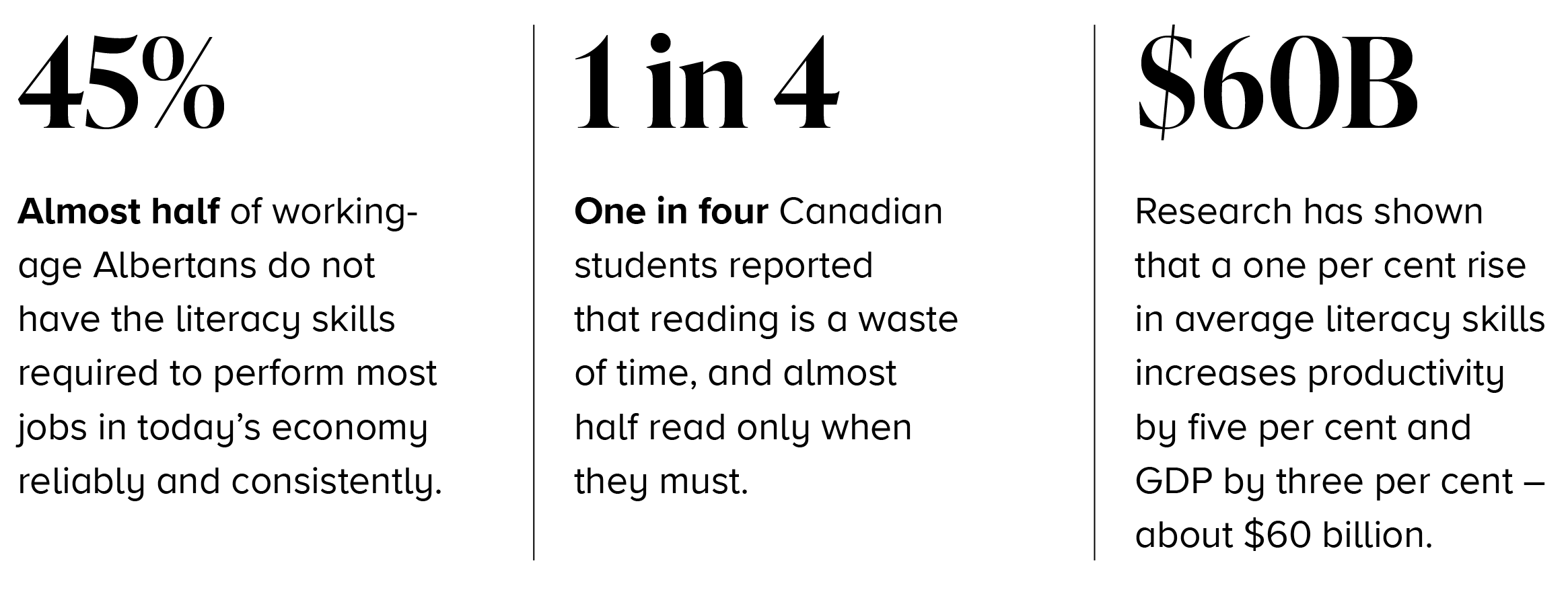Project funding provided by Calgary Reads and The Rotary Club of Calgary.
EXECUTIVE SUMMARY | Janet Lane, Director, Human Capital Centre | April 2023
Literacy is the learning to learn skill
The demand for literacy skills in the workplace continues to rise as individuals face new technologies, new work processes, more advanced machinery, changes to regulations and new co-workers, all of which demand good or better levels of literacy. Workers must be able to understand what they have read and then apply that understanding to solve new problems.
Unfortunately, almost half of working-age Albertans do not have the literacy skills required to perform most jobs in today’s economy reliably and consistently.¹ They are even less prepared for the jobs of tomorrow.
Workers with low literacy levels, on average, work less productively, increase the need for do-overs, are involved in more workplace accidents, have poorer health and are more likely to be absent and are less adaptable to change.² Research has shown that a one per cent rise in average literacy skills increases productivity by five per cent and GDP by three per cent – about $60 billion.³

Literacy is the learning to learn skill. First we learn to read; then we read to learn. International studies of adult skills measure literacy based on an individual’s ability to read and to process what is read. At the lowest literacy levels, people can retrieve information and apply it in routine, predictable ways. At higher levels people can analyze, evaluate and create new information based on what they read. This higher literacy level is needed to solve problems, think critically and be creative, the skills that are more and more in demand. At a time when workers face harder problems and require higher literacy levels, the proportion of adults with adequate skills, including those aged 16-25, has fallen over time.
The good news is that Alberta’s 15-year-old students score above the Organization for Economic Cooperation and Development average on international assessments of reading skills. The bad news is that their average scores have also steadily fallen. What’s more, the latest study showed that one in four Canadian students reported that reading is a waste of time, and almost half read only when they must.⁴
People with lower levels of literacy may have difficulty finding and retaining satisfying and appropriate employment — particularly in secure and well-paying jobs.⁵ What’s more, higher literacy skills increase a person’s probability of earning a higher income and having and maintaining good health.⁶ People with higher literacy skills are also more likely to be more socially engaged, to volunteer and have more trust in people and institutions.⁷ These effects have profound implications for social cohesion and quality of life for all.
Literacy begins with language learning from birth and can be gained and lost throughout life with instruction and practice – or the lack of it. With quality instruction and early assessment in school, combined with targeted interventions, almost every child can learn to read.
While much of the solution to this pervasive and persistent literacy problem requires education systems to change what they do, how and when they do it and for whom, this will not be enough.
The solutions to Alberta’s literacy problem cross all life stages and all are required for Albertans to build and maintain skills they need to help themselves and the province flourish.
The Case for Literacy in Alberta
The following recommendations are targeted to various life-stages:
01.
Literacy begins in the home and can be nurtured from birth. Parents are their children’s first teachers. They build language and literacy skills every time they talk, sing, read and play with their babies and toddlers.
About half of pre-school children in Canada attend daycare centres where opportunities for literacy learning through play abound. However, fewer than half of day care workers surveyed in 2021 engage children in daily, early literacy activities.⁸
Recommendations for parents and parental supports
Ensure that babies and toddlers build language and pre-literacy skills. This means that friends, family, community members and professionals provide encouragement and supports for literacy to young children and parents they encounter.
Daycare centres and pre-school programming be held accountable to provide quality literacy activities daily. This means that all staff receive appropriate training.
02.
While K-12 education systems across the country achieve high rates of reading success, work is still necessary to ensure that every child reads at grade level by the end of Grade 3.
Recommendations for education systems
Assess every child’s reading readiness as they enter school and throughout their early schooling. Identify the extent of any problem and the individual children. Provide financial and instructional resources for interventions targeted to the individual needs of each child who might fail to learn to read. Ensure teachers in primary grades have deep knowledge about how to teach children to read.
Encourage K-12 learners to read deeply for information, learning, interest and pleasure, both in print and on digital devices. Include age appropriate, relevant and interesting material in the curriculum and make it readily available for all learners.
03.
Unfortunately, many post-secondary students with learning problems may not be aware their learning difficulties could stem from weak literacy. They will struggle to learn the content, fail to learn key competencies and may drop out of their programs unless literacy challenges are assessed and addressed.
Recommendations for post-secondary institutions
Assess post-secondary learners upon entry for their literacy capacity and provide targeted instruction if needed.
04.
Workers with literacy levels below what is required by their jobs impact productivity, absenteeism and safety.
Recommendations for employers
Embed literacy into onboarding and ongoing training of workers, especially for jobs that are becoming more knowledge intensive.
05.
Older adults can lose literacy skills if they do not maintain their literacy practice. The direct correlation between literacy levels and health care, volunteerism and citizenship make it important that older adults be encouraged to engage in activities which use literacy.
Recommendations for community organizations
Continue to advocate for funding to include literacy rich activities for all age groups including family literacy programming which is the gateway to learning for adults who experience marginalization.
That said, the most effective and efficient ways to reduce the cost of low literacy, both in dollar and human costs, are to provide literacy materials and supports early in the lives of children.
Endnotes
¹ Skills in Canada: First Results from the Programme for the International Assessment of Adult Competencies (PIAAC).
² What You Don’t Know Can Hurt You Literacy’s Impact on Workplace Health and Safety. Conference Board of Canada. 2010.
³ Lane, Janet and Murray, T. Scott, Literacy Lost: Canada’s Basic Skills Shortfall. Canada West Foundation. 2018
⁴ O’Grady et al, “Performance of Canadian 15-year-olds”
⁵ Linda Jacobsen and Andrea Long, The Health and Social Dimensions of Adult Skills in Canada: Findings from the Programme for the International Assessment of Adult Competencies (PIAAC) (Ottawa: Council of Ministers of Education Canada, 2018).
⁶ T. Scott Murray and Richard Shillington, Understanding the Link between Literacy, Health Literacy and Health, (Ottawa: DataAngel, 2012), http://www.dataangel.ca/docs/UnderstandingtheLink2012.pdf
⁷ Jacobsen and Long, Health and Social dimensions.
⁸ Canadian Children’s Literacy Foundation. The Role of Early Literacy in Early Learning and Child Care: A Survey of Early Childhood Educators (Toronto: Canadian Children’s Literacy Foundation, 2022). https://childrensliteracy.ca/cclf/media/PDFs/ECE-Survey.pdf

